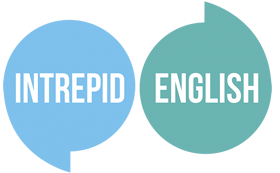Do you know how to use possessive adjectives and pronouns in English? In today’s blog post, we’ll explain what the difference between a possessive adjective and a possessive pronoun is, and test your knowledge with a practice activity.
Don’t forget, Intrepid English Members can also download a Possessive Adjectives and Pronouns worksheet as part of our self-study Fast Grammar course.
What is a possessive adjective?
You have probably heard in previous English lessons that an adjective is a describing word. Possessive adjectives describe who a noun belongs to. They show possession. Adjectives go before the noun in English.
The possessive adjectives are as follows:
| Possessive Adjectives |
| My |
| Your (singular) |
| His |
| Her |
| Its |
| Our |
| Their |
| Your (plural) |
Let’s look at some examples.
This is Nicola. She is my sister.
Here is my dog, and here is his toy.
Welcome to our home! May I take your coat?
Making the possessive form of a name
To form the possessive form of a name, we add apostrophe + ‘s’.
For example:
This is Lorraine’s laptop.
We went to Juan and Melissa’s party.
I’m in Mr. Kendall’s group for maths.
What about names that end in ‘s’?
For name’s ending in an ‘s’, style guides vary. While some recommend adding an apostrophe and an extra ‘s’, others recommend just adding an apostrophe.
- James’s team were top of the leader board.
- James’ team were top of the leader board.
Following either rule is fine, just be consistent throughout your text.
For plural possessives of names ending in an ‘s’, always insert the apostrophe after the final s.
- We had dinner at the Harris’ house.
- I am dog-sitting the Peters’ dog this weekend.
Practice activity
Practice possessive adjectives by filling in the gaps below with an appropriate possessive adjective.
- I am going on holiday with ____ brother next week.
- Linda loves ____ new shoes! She’s been wearing them every day.
- We are thinking of re-decorating ____ living room. Where did you buy ____ wallpaper? It’s really nice, we would love something similar.
- The people are very proud of ____ city’s heritage.
- Mexico is a country which is known worldwide for ____ delicious street food.
- Abdullah didn’t want to share the cake with ____ sister.
- I spoke to ____ mum and dad about ____ holiday plans last night. They’re planning to go to Greece.
What is a possessive pronoun?
Possessive pronouns take the place of the possessive adjective and the noun.
If we have already mentioned who the item belongs to, we can use a possessive pronoun to avoid repetition and sound more natural.
For example:
This is my car. It’s mine.
That’s Sarah’s book. It’s hers.
They are our cats. They’re ours.
Study the table below:
| Subject Pronoun | Object Pronoun | Possessive Adjective | Possessive Pronoun |
| I | me | my | mine |
| You | you | your | yours |
| He | him | his | his |
| She | her | her | hers |
| It | it | its | its |
| We | us | our | ours |
| They | them | their | theirs |
Practice activity
Rewrite the sentences using the correct possessive pronoun. Follow the example.
- These are my shoes. They are mine.
- This is not John’s [he/him] pen. It isn’t ___.
- The Honda is our car. It is ___.
- The blue coat is Emily’s [she/her]. It is ___.
- Come round to our house for dinner. Come round to ___ for dinner.
- We didn’t have water, so we went to their house to take a shower. We went to ___.
- I bought this vase as a gift for you. It is ___.
Well, I hope you found this bitesize grammar blog post useful. If you’re an Intrepid English Member, don’t forget to download your Possessive Adjectives and Pronouns worksheet!
